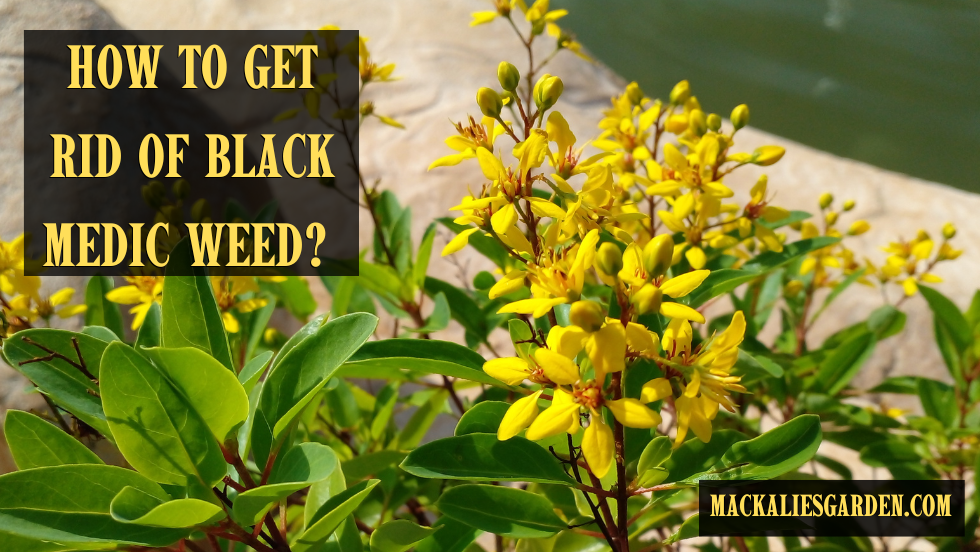As a botanical expert, I am pleased to present this comprehensive guide on Black Medic Weeds (Medicago lupulina), which are often misidentified as clover with yellow flowers.
By understanding the defining characteristics of this noxious weed, its preferred environments and regions, and the effective methods for controlling and preventing its growth, you will be better equipped to maintain a healthy, weed-free garden or lawn.
How to Get Rid of Black Medic Weed?
Physical Features & Identification Black Medic Weeds
Black Medic, also known as Yellow Trefoil or Hop Medic, has distinct properties that set it apart from common clover:
- Leaves: Black Medic possesses compound leaves comprising three oval-shaped leaflets. These green leaflets feature a pale watermark in a chevron pointing towards the leaf attachment, a key distinguishing factor from clover.
- Flowers: The flowers are small, bright yellow, and feature a pear-shaped structure. They are clustered in groups of 10-50, creating an umbrella-like formation on the end of elongated stalks.
- Color and Size: Black Medic can grow up to 18 inches long, with stems that trail across the ground or climb other plants. The stems and leaf veins have a dark purple to blackish hue, which gives this weed its name.
Geographical Distribution and Growing Conditions
Black Medic can be found in various regions, including North America, Europe, Asia, and Africa. This weed prefers well-drained soils and tolerates many soil conditions, including poor fertility and compacted areas. It thrives in sunny or partially shaded environments and competes with other plants for nutrients. This weed often grows from late spring to early autumn.
Health Risks and Environmental Concerns
Although Black Medic is not known to pose severe health risks to humans or animals directly, it can become a dominant species in lawns and gardens, outcompeting desirable vegetation. Additionally, its dense root system may interfere with the growth and establishment of desirable plants, limiting their access to vital nutrients.
Control and Prevention Tips for Black Medic Weeds
Black Medic (Medicago lupulina) is an invasive annual weed that can grow aggressively in lawns, gardens, and other cultivated areas. It’s small clover-like yellow flowers, and nitrogen-fixing roots can outcompete desirable plants for nutrients and sunlight.
Here are some practical ways to control and prevent this troublesome weed:
1. Maintain a Healthy Lawn and Garden
A robust and healthy lawn provides fierce competition, leaving little room for black medic weeds to thrive. Some steps to achieve this include:
- Proper watering: Water deeply and less frequently to encourage strong root growth.
Fertilization: Apply the appropriate nutrients to your soil based on its needs. A soil test can help determine nutrient deficiencies.
Mowing: Keep grass at 3-4 inches to promote dense growth and discourage weed development.
2. Mechanical Removal
Hand-pulling and hoeing effectively curb black medic weed invasion in gardens and flower beds. Be sure to remove the entire root system to prevent regrowth. This method is best for small infestations or preventative measures.
3. Solarization
If black medic weeds have become a severe problem, solarization can help eradicate them from the soil.
This method involves placing a clear plastic sheet over the soil during the summer months to trap heat and minimize the chances of weed survival.
This technique takes several weeks to months and is most effective in areas with prolonged periods of high temperature and sunshine.
4. Mulching
Apply a 2-3 inch layer of organic mulch around your plants to help smother black medic weeds and prevent their germination. Some options include shredded bark, grass clippings, and straw. This method controls weeds and improves soil health and moisture retention.
5. Pre-emergent Herbicides
If you want a chemical control method, apply a pre-emergent herbicide in late winter or early spring before black medic seeds germinate. Follow the label instructions and use as directed to ensure effective control and avoid harm to desirable plants.
6. Post-emergent Herbicides
For existing black medic weeds, consider using a selective post-emergent herbicide explicitly formulated to target broadleaf weeds. Ensure that you follow the instructions on the label to prevent damage to neighboring plants or grass.
7. Preventative Measures
Practice good hygiene by cleaning tools, shoes, and even pets after being in infested areas to avoid spreading seeds throughout your property.
The Best Herbicide For Black Medic
There are numerous herbicide brands available that effectively control Black Medic weed. The choice of herbicide for your lawn may depend on its availability. Many selective broadleaf weed control herbicides found at local box stores or hardware stores can be effective against this weed.
on its availability. Many selective broadleaf weed control herbicides found at local box stores or hardware stores can be effective against this weed.
When shopping, look for key ingredients such as triclopyr, dicamba, and clopyralid, which are active ingredients that effectively kill Black Medic. I have achieved the best results with T-Zone from ITS Supply. It is a selective turf herbicide that does not harm most lawn grasses but proves highly effective against Black Medic. You can purchase it on Amazon.
Final Words
Black weeds are a nuisance to any garden or lawn, as they can outcompete desirable vegetation and take up space.
By arming yourself with the proper knowledge and control methods for Black Medic, you will be better equipped to maintain a healthy, weed-free garden or lawn.
With consistent effort and diligent attention to your plants, you’ll have an inviting outdoor oasis in no time.

Douglas Mackalie is a Founder of Mackalies Garden. He is one of the most exciting people you’ll ever meet. He has 25 years of experience in horticulture and gardening, most of which he’s spent outdoors getting his hands dirty.

